There’s nothing quite as shiny and polished as a brand-new Moka Pot. But as every Moka Pot owner knows, it’s only a matter of time before it develops those black oxidation spots. What causes Moka Pot oxidation and what exactly can we do about it?
Generally, aluminum Moka Pots are susceptible to oxidation and can easily become tarnished or develop black spots if they’re abraded or washed with harsh detergents. However, the aluminum oxide that forms is a stable compound that protects Moka Pots from corrosion and does not affect coffee flavor.
So, although your Moka Pot may have small oxidation spots, these spots don’t hurt your Moka Pot or your coffee.
But, keep in mind that black spots don’t always mean oxidation. Sometimes, they could be the result of coffee stains or mold. How can you tell the difference and what should you do about it?
Keep reading to find out!
Why Do Moka Pots Develop Black Spots?
There are two main causes for Moka Pots to develop black spots.
- Oxidation
- Mold
While oxidation is by far the most common of the two, let’s take a look at both of these scenarios to see what’s going on here.
Related Posts:
- Are Moka Pots Dishwasher Safe? Here’s What To Expect!
- 16 Moka Pot Mistakes To Steer Clear Of!
- Can I Drink Leftover Moka Pot? Here’s How To Do It Safely!
- Aluminum vs Stainless Steel Moka Pot ( Which One To Pick?)
Black Spots Caused By Oxidation
The very first Bialetti Moka Pot was made of aluminum. This metal was chosen because it’s relatively soft and cheap and conducts heat easily.
While there were several benefits to choosing aluminum, there was one noticeable issue: aluminum is highly reactive to oxygen.
Even today most Moka Pots are still made of aluminum alloys, but many are coated with a material to prevent oxidation.
However, harsh detergents and abrasive scrubbing can remove this protective coating which makes it easier for oxidation to occur.
When you’re dealing with oxidation, the black spots can’t be removed by simply wiping the pot. Instead, the spots will be part of the surface of the metal.
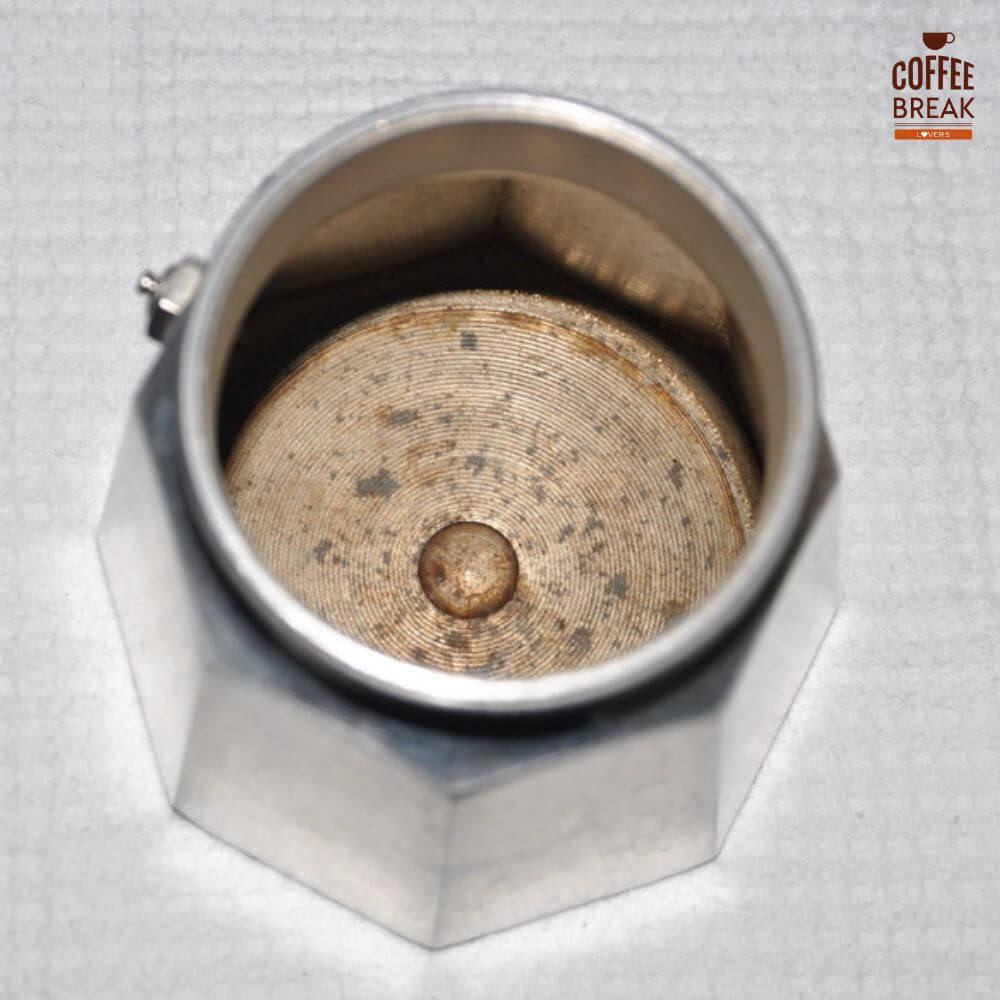
Black Spots Caused By Mold
Sometimes, the black spots in your Moka Pot may indicate the presence of mold.
Typically, mold won’t grow in your Moka Pot unless there’s some organic material left there such as dried coffee or old coffee beans.
Telling the difference between oxidation spots and mold is quite easy to do if you take into account the following:
- Unlike oxidation spots which are bonded to the metal, mold can be easily brushed away.
- Mold will have a smell to it
- Mold will grow wherever it can, so, if it’s in the bottom chamber, it may also be in the funnel, the filter, the spout leading up to the top chamber, and the top chamber itself.
How Do You Remove Oxidation From A Moka Pot?
To remove oxidation spots from your Moka Pot, start by washing it with warm water and a few drops of mild dish liquid. This will remove any large debris that is in the brewer.
Second, scrub your Moka Pot with a mixture of water and white vinegar to remove the stains. Remember to thoroughly dry your Moka Pot as any remaining water can create additional spots.
Alternatively, you can scrub your pot with a paste made out of water and cream of tartar. This paste is proven to work well for cleaning old, tarnished Moka Pots externally and should be quite effective on small internal spots as well.
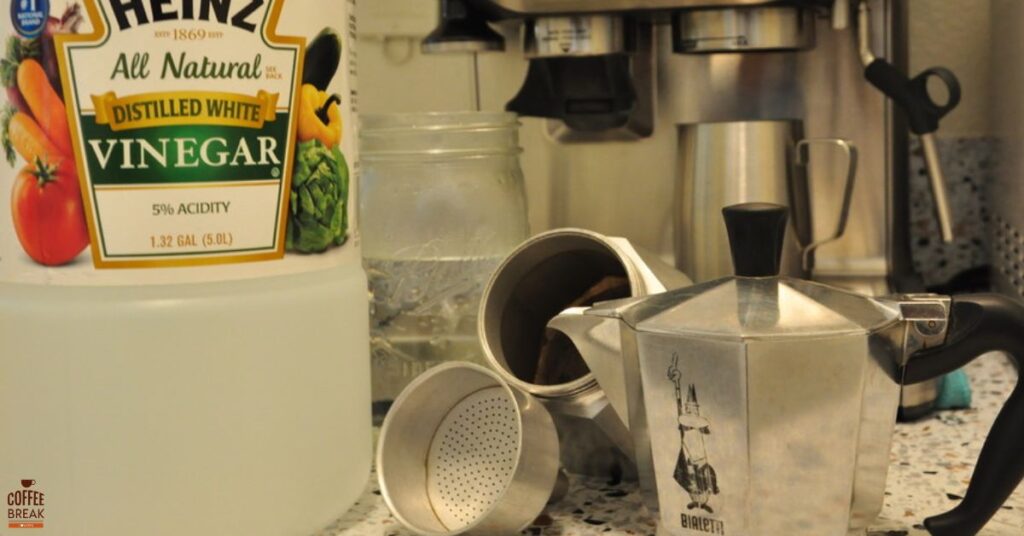
How To Remove Mold Spots From My Moka Pot?
If the black spots on your Moka Pot are, in fact, mold, you should be able to easily remove it with a brush or cloth.
Just keep in mind that brushing away the visible mold won’t be enough. Instead, you’ll need to completely disassemble your Moka Pot and clean each piece thoroughly with hot water, soap, and/or vinegar.
Because there are plenty of small and hard-to-reach spaces in a Moka Pot, you may even want to let your disassembled pot sit in boiling water to make sure you kill all of the mold.
Make sure you pay special attention to the Moka Pot’s gasket. This rubber piece is porous so mold can penetrate down into the gasket.
If you’re unable to completely kill all the mold with hot water, vinegar or bleach, you may want to consider buying a new gasket.
You can find replacement gaskets on Amazon. (If you need help figuring out what size you need, take a look at our article “Moka Pot Size Guide“.)
Related Posts:
- Best Grind Size For A Moka Pot?
- What Are The Parts Of A Moka Pot? (Easy Assembly Guide!)
- Can You Use Milk In A Moka Pot? Here are our Results!
What Are The White Spots In My Moka Pot?
Instead of black spots, you may find white spots in your Moka Pot. If white spots appear, it’s typically caused by mold or limescale buildup.
In the case of mold, thoroughly clean your Moka Pot with boiling water, soap, and/or vinegar just as we mentioned in the previous section.
However, if the white spots are caused by limescale, you’ll want to scrub the spots away using hot water and vinegar.
Limescale is caused by a build-up of calcium carbonate from using hard water. To prevent this, it’s best to use filtered water in your Moka Pot.
Is It Safe To Use An Oxidized Moka Pot?
It’s generally safe to brew coffee in a Moka Pot that has oxidation spots.
The oxidation spots in a Moka Pot are either aluminum oxide or hydrated oxide. Both of these compounds are stable and don’t react with other materials.
This means two things.
First, these compounds protect your Moka Pot from additional oxidation. Second, they don’t interact with your coffee.
So, while you may not appreciate how those oxidation spots look, they won’t harm your coffee.
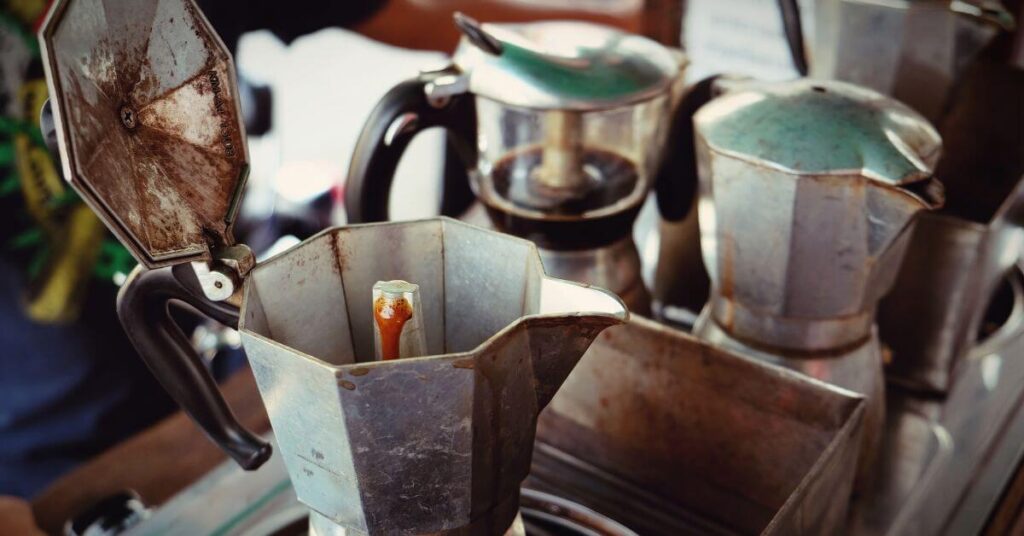
Related Posts:
- Should You Use Hot Or Cold Water In A Moka Pot?
- Why Does My Moka Pot Sputter (And 6 Easy Ways To Fix It!)
- Should I tamp a Moka Pot/ Here’s What You Need To Know!
How Can I Prevent Moka Pot Oxidation?
There are several things you can do to keep your Moka Pot shiny and polished for as long as possible.
- Don’t use harsh detergents to clean your Moka Pot
- Don’t use abrasive or metal brushes to scrub your Moka Pot
- Completely dry every part of your Moka Pot after washing
- Never put your Bialetti Moka Pot in the dishwasher
Basically, the best way to prevent your Moka Pot from oxidizing is by washing it gently and drying it completely.
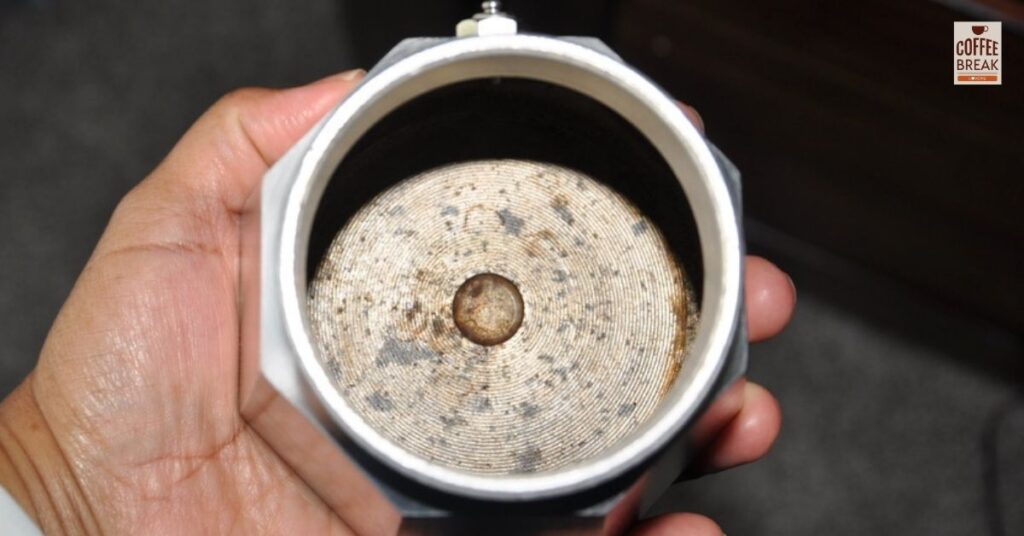
Will Aluminum Get In My Coffee If I Clean My Moka Pot?
There’s research showing that when a Moka Pot is put in the dishwasher, the next batch of coffee brewed contains a higher amount of aluminum. (Paper available at the National Institute of Health.)
This most likely happens because the surface layer of aluminum was scuffed during washing which exposes new aluminum.
And remember, aluminum is a relatively soft metal that is highly reactive. So, in addition to leaching aluminum into your coffee, the newly exposed metal will oxidize easily and create dark spots.
(If you want to read more about aluminum in coffee, take a look at our post “Aluminum vs Stainless Steel Moka Pots“.)
Related Articles:
- Stovetop Percolator Guide: Best Old-School Coffee Brewer
- 6 Siphon Coffee maker To Create A Unique Coffee Experience
- Breville vs De’Longhi: Best Espresso Machine 2022!
- Turkish Coffee Grinder: How To Choose The Best!
Are There Any Moka Pots That Don’t Oxidize?
Moka Pots made from aluminum alloys are the ones that are susceptible to oxidation. By comparison, stainless steel Moka Pots don’t have this problem.
Stainless steel Moka Pots are typically made of iron, chromium, and nickel alloy, so they maintain their color and are much easier to clean than the aluminum version.
If you’re interested in stainless steel Moka Pots, follow our link for a great option on Amazon.
Moka Pot Oxidation- Key Takeaways
- Black spots in a Moka Pot are typically due to oxidation or mold.
- Moka Pot oxidation spots can be scrubbed away with warm water and vinegar
- Aluminum Moka Pots should not be cleaned with abrasive brushes, or harsh detergents or placed in the dishwasher
- Stainless steel Moka Pots keep their color and are easier to clean than aluminum pots
Cheers Coffee Lovers!

KEEP READING
- Bialetti Brikka vs Moka Express (Which Should I Choose!?)

- Best Bedroom Coffee Maker (Top 6 Picks!)

- Are Blade Grinders Really That Bad?

- 16 Moka Pot Mistakes To Steer Clear Of!

- What Are The Parts Of A Moka Pot? (Easy Assembly Guide!)
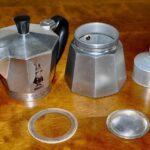
- Do Moka Pots Work On Induction Stoves? (Why Or Why Not?)

- What’s The Best Induction Moka Pot? (Top 5 Picks!)

- Moka Pot Oxidation (Why Are Black Spots In My Moka Pot?)

- Moka Pot Size Guide (What Size Moka Pot Do I Need?)


Idalmis is co-owner of Coffee Break Lovers. She is a Cuban coffee enthusiast that is passionate about coffee and coffee culture.


